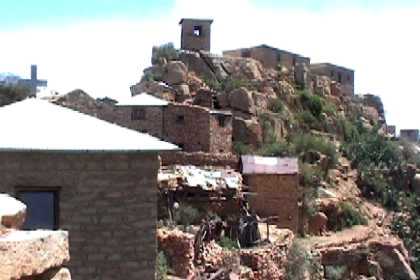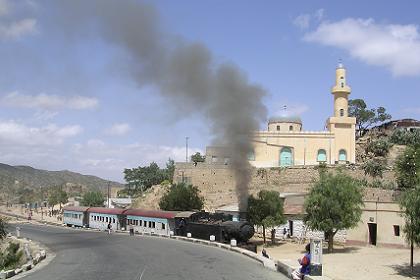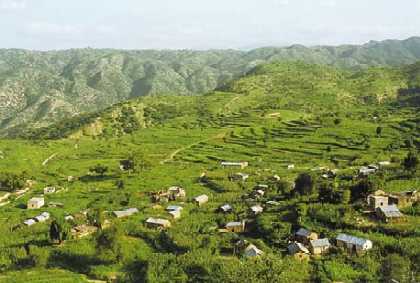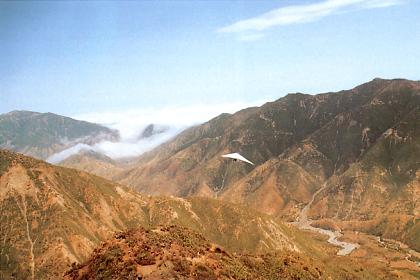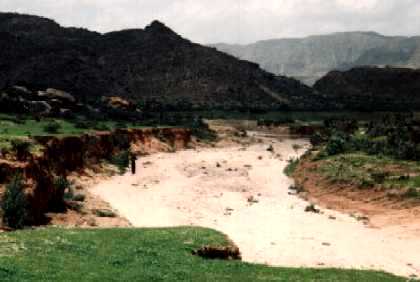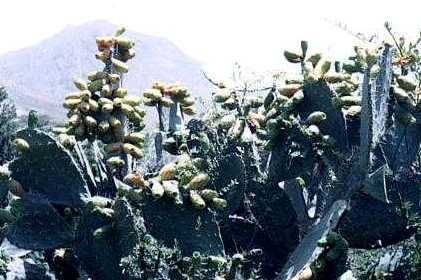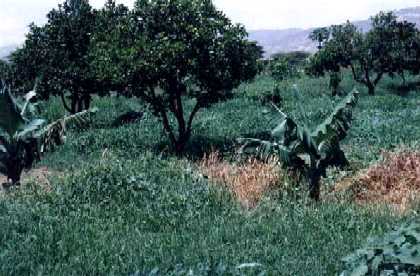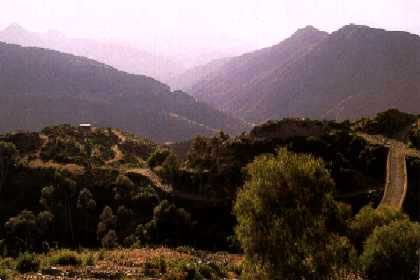Map of Eritrea
Location and geography
Eritrean history
Border conflict with Ethiopia
Political structure
Eritrean anthem
Economy & currency
Climate
People
Languages
Religion
Health care
Transport
Cuisine
News, links, books and more
Asmara (Asmera)
Agordat (Akordat)
Assab (Asseb)
Barentu
Dahlak islands
Dekemhare (Decemhare)
Ghinda (Ginda)
Keren (Cheren)
Massawa (Massauwa)
Mendefera (Adi Ugri)
Nakfa (Nacfa)
Semenawi Bahri (Filfil)
Tessenei
(Teseney)
Hamasien Eritrea
Leaving Asmara you pass the zoo and the British war cemetery. The road from Asmara to Massawa in the Hamasien province offers many scenic panoramas when the road begins its snake-like path down the escarpment. Often the hilltops are hidden in thick white clouds. Bar Durfo, 10 kilometers from Asmara is a nice place to stop and enjoy the spectacular views.
Nefasit - Debre BizenAbout 24 kilometers by car from Asmara is the small town of Nefasit. On the top of Mt. Bizen, that raises 2,700 feet (825 m) above Nefasit is the monastery of Debre Bizen. The monastery was founded by Abune Phillipos in 1361 and survived various rulers as a result of its unique position. The monastery is actually a small village of a few dozen stone monk's houses, three churches, some classrooms and agricultural support buildings. Debre Bizen homes some 60 monks, who chose to live an austere life, and a fluctuating number of students in its religious school. They are the custodians of Debre Bizen's collection of more than 1,000 medieval manuscripts, including fine illustrated parchments bound in thick leather, cloth and wood.
Once very prosperous, most of the monastery's property was confiscated during the time of the Dergue's occupation, which actively discouraged religious institutions The Dergue's culture commissars told the monks that religious artifacts should be burned. During the Dergue regime, the monastery was used as a military base to keep watch over the surrounding region. Today the only invaders are a family of baboons who regularly raid the monastery's meager food supplies brought up the mountain by donkeys and camels.
The Debre Bizen Monastery - Like an eagles nest on the mountain
It is possible for men to visit the monastery, but the only way to make the 825 meter, 7km climb to the top is on foot (which takes, depending on your condition, between one and a half and three hours). The reward for those who endure the grueling climb is a spectacular view of the surrounding barren mountains. The Red Sea, some 80 kilometers distant, is visible from here on a clear day.
The sign says "No females beyond this point. Of any species. Turn back now." Woman are denied entrance to the monastery and its surroundings. These rule applies also for female pack animals (!)Birds are excepted from this rule for practical reasons, and hens are allowed for the production of eggs. Abune Phillipos wanted to avoid the distractions of local girls. Abune Phillipos is rumored to have said that he would "rather stare into the face of a lion than into a woman's eyes."
The best time to make the climb is in the early morning and return in the late afternoon. It is customary to leave the monks a contribution to aid in the maintenance and reconstruction of the monastery.
The annual celebration of Debre Bizen Abune Libanos is on August 11.
NOTE: No visits without an introduction from the monastery's liaison (The Patriarchate of the Orthodox church of Eritrea / Orthodox Tewahedo Church Headquarters in Asmara tel. 18 20 98 or 18 65 44).
More pictures of Debre Bizen > > >
The Thinking of Bizen
Perhaps the most fascinating history of Debre Bizen is that it has devised its own calendar, invented by a certain monk called Gebremeskel and known as Hasabe Bizen (The Thinking of Bizen). It has 35 columns and was based on Hebrew and Christian calendars. The dating started from the creation of the earth and ended at the year 1500 AD, because the inventor believed that the year 1500 AD would be dooms day or the end of the world. The calendar has not been used since 1500 AD. It lags 236 years behind the Gregorian calendar. Had it been in use, now the year according to Bizen Calender or 'The Thinking of Bizen' would be 1766.
Train passing the mosque of Nefasit
Valley along the scenic Asmara
Gliding over the escarpment of Durfo - 9 kilometers from Asmara.
Dry riverbed Ala valley
Beles (Prickly Pear) at Ala plantations
Lemon and banana trees at Ala plantations
Deep valleys and dramatic mountains in the Highlands of Eritrea.
